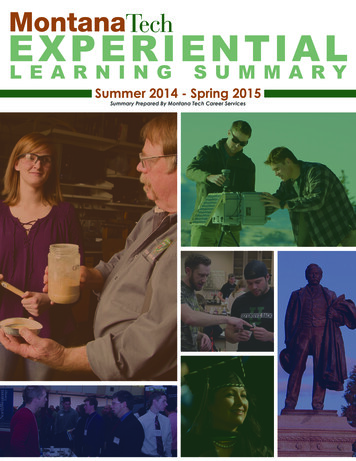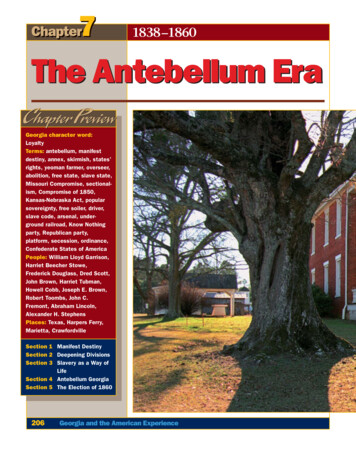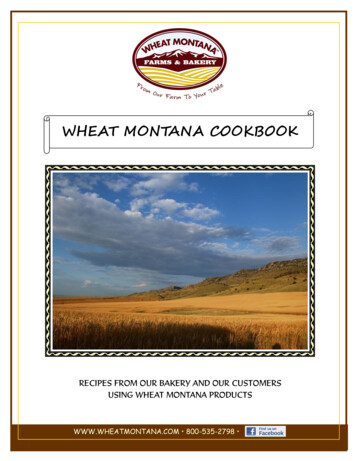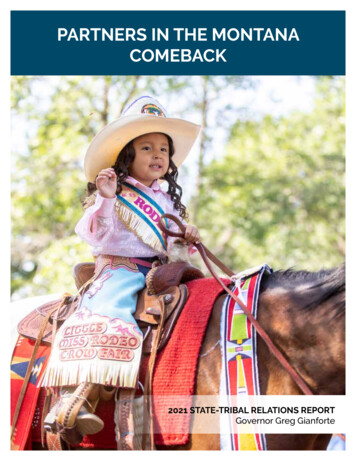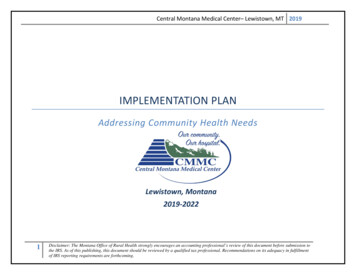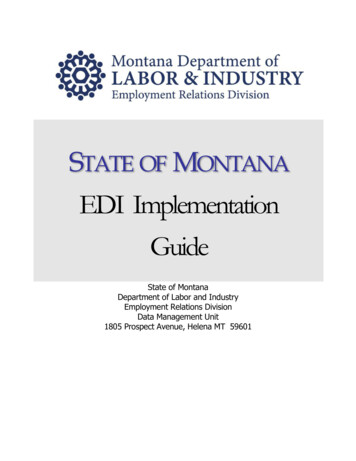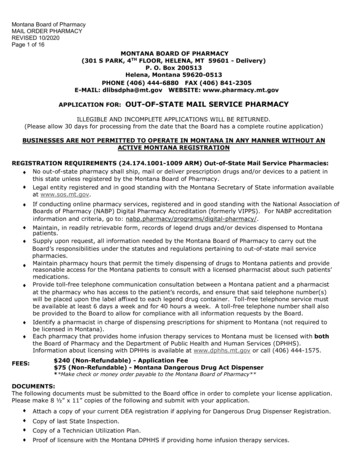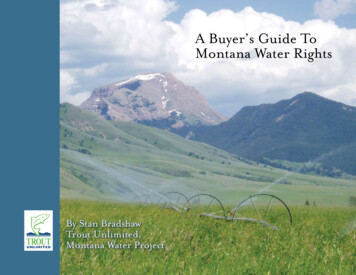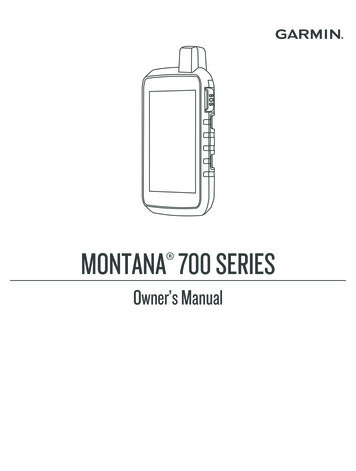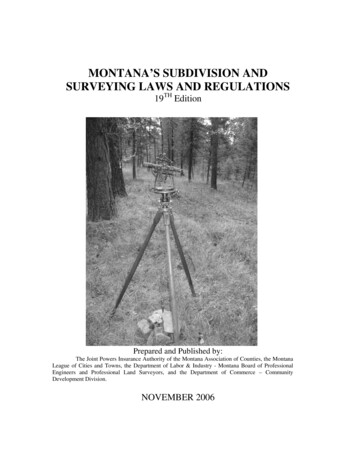
Transcription
FIGURE 6.1: Wagon Trains at Helena, Montana, 1874, by William de la Montagne Cary1837–40Smallpox epidemics killmany Montana Indians18301001841Father DeSmetbuilds St. Mary’sMission18401861–65Civil War1848California gold rush18501852Benetsee finds goldin the Deer Lodge 0First steamboat arrives in Fort Benton1862Montana gold rush begins1863Bozeman Trail opens
READ TO FIND OUT: How new ideas change the landscape How the gold rush changed Montana The difference between placer mining and quartz mining Why mining camps needed to establish Montana TerritoryThe Big PictureGold discoveries triggered a flood of new peopleinto Montana. They used and thought about the landin an entirely different way than the Indian tribes whohad made their homes here for thousands of years.Of all the words spoken throughout Montana’s past, you could say that oneword has changed the landscape more than any other: “Gold!”The discovery of gold in Montana in the 1860s brought thousands of peopleof many cultures and backgrounds to the Rocky Mountains. These newcomers held different beliefs than the people who lived here. They had a differenteconomy—based on gold instead of furs or trade goods—and they used different methods of transportation. They brought fears and expectations that theyhad formed long before they got here. They imposed their ideas on the land andon one another.They also adapted to their new land, just as everyone throughout timehas done.The discovery of gold changed the landscape of Montana. Mines multipliedin the gulches. Towns sprang up nearby. Farms spread through the valleys.Ancient trails and pathways became wagon roads.Gold also created a new economic pattern in Montana: the boom-andbust cycle. Each gold discovery brought sudden activity followed by decline,then a period of quiet, and then a sudden burst of activity again in another location. This boom-and-bust cycle defined Montana’s economy during the GoldRush Era, and it continued to shape life in Montana and all across the West forthe next 100 years.1869First transcontinentalrailroad completed1874–87Indian reservationsmade smaller18701874Silver boom beginsin Montana1876Battle of the Little Bighorn1879Edison patentslong-lastinglight bulb1883Fewer than 200bison remain onthe Plains18801880First trainentersMontanaTerritory1889Montanabecomesa state18901883Northern Pacific Railroadcompletes transcontinental route1883Copper boom begins in Butte19001893Panic of 1893 and collapseof the silver market4 — NEWCOMERS EXPLORE THE REGION101101
First Gold Rush in the West: California, 1848The first gold rush in the West started in California in1848. One man discovered gold at Sutter’s Mill, andnearly 250,000 people dashed to California to seektheir fortunes.The pattern repeated across the West. Prospectors(people who search for gold)—usually young, eager,restless men—fanned out into the creeks and gulchesof mountain ranges. Merchants and farmers rushedin after the miners to sell them supplies, food, andmining equipment. Each major gold strike triggereda new wave of people. Prospectors worked an areauntil it played out (no longer yielded gold) andquickly moved on. By the 1850s some of them hadmade their way to Montana.Three Major Strikes in MontanaFIGURE 6.2: One of Montana’s first goldcamps, the town of Pioneer City grewup to supply and support the prospectors and miners around Gold Creek inthe Deer Lodge Valley. Like many goldcamps, it was quickly abandoned whenthe gold played out.In the early 1850s a fur trapper called Benetsee (hisMétis name was François Finlay) discovered a smallamount of gold in the Deer Lodge Valley—not much, but enough tostart people talking.A few years later, brothers Granville and James Stuart found goldnearby. But they ran out of salt and lost four horses in a Blackfeet raid,so they decided to keep moving. When they returned, they staked a claimon a spot they named Gold Creek and wrote to their brother in Colorado,urging him to come north. No gold discovery remained a secret long. Thatletter sparked a small stampede into Montana.Grasshopper Creek Made the City of BannackOn a hot July day in 1862, a prospector named John White and his partner William Eads found gold along a tributary of the Beaverhead River(in southwest Montana). The grasshoppers were so thick that the minersnamed it Grasshopper Creek. Their excitement attracted miners from thewhole region. Four hundred people flocked to the scene that summer.Soon miners had marked out and claimed the entire length ofGrasshopper Creek. They built a little town and named it Bannack Cityafter the nearby Bannock Indians. By the following April, 1,000 peoplelived there.Grasshopper Creek produced 5 million in gold dust (worth 90 million today) in its first year. It also produced some outrageous rumors.Some said they could pull up a sagebrush plant, shake the roots out overa pan, and collect a dollar’s worth of gold.Claims like this lured all sorts of people with high expectations. They102PART 2: A CENTURY OF TRANSFORMATION
“discovered that mining required endless toil inEmigrants are pouring in and the wholeharsh weather—”grueling labor even to mencountry is one bustle of excitement.used to hard work,” as prospector Ed Morsman—JAMES MORLEY (C. 1863)wrote in a letter to his family in 1865.Many spent all they earned just to get by, or arrived at a discoverytoo late to stake a good claim. As James Morley wrote in his diary in1863, “Labor is abundant and many are disappointed.” These disappointed latecomers fanned out across the landscape, seeking their ownbonanza (rich mineral deposit).”Alder Gulch: Almost an AccidentIn May 1863 two prospecting parties left Bannack to search for gold inthe Yellowstone River region. This was Crow territory. The Crow hadlittle patience for gold prospectors because they trespassed on Crow landbut offered nothing of value to trade. They chased off the first group.When they met the second party of prospectors, the Crow took theirhorses and equipment, turned them around, and sent them back wherethey came from.This second party included a man named Bill Fairweather. On theirway back to Bannack, Fairweather and his companions camped alonga stream in the Ruby River Valley that was tangled with alders (thickbushes). After supper Fairweather scratched at the bedrock with hispocket knife to see if he could find “enough money to buy a little tobacco.” Moments later he shouted out, “I’ve found a scad!”A “scad” meant “a lot.” The nextday they recovered 200 worth of gold( 2,900 today). Within a few monthsthousands of people flooded into AlderGulch to take part in Montana’s richest gold discovery. By the year’s endthe gulch had become a string of towns14 miles long called “fourteen-Mile City.”The biggest town was called Virginia City.FIGURE 6.3: By the end of the 1860s, AlderGulch looked like this. Hydraulic mininghad eroded the soil down to bare rock,most of the trees were cut down, andwooden flumes (channels) redirected thestream water to the mining operations.Last Chance Gulch:Just About to Give UpAs always, as soon as Alder Gulch wasfully staked with miners’ claims, rumorsbegan to fly about gold somewhere else.Among those who raced after such rumors were four men who later werecalled the “Four Georgians” because theyused a gold-panning technique called the“Georgian method.”6 — MONTANAʼS GOLD AND SILVER BOOM103
After several disappointing months of prospecting, the FourGeorgians decided to try their luck on a little gulch in the Prickly PearValley. That little creek, they decided, would be their last chance.On July 14, 1864, they began working the gulch. Bonanza! Theyfound gold plentiful and easy to remove. By fall, more than 100cabins teetered on the hillsides on either side of Last Chance Gulch.On October 30 the community named their new town Helena. Overthe next four years, Last Chance Gulch produced 19 million worthof gold (approximately 221 million in today’s dollars).Hard Work and “Slim Pickin’s”FIGURE 6.4: This is the gold pan that BillFairweather’s partner, Henry Edgar, usedto wash gold out of Alder Creek. A pickand a pan were the gold prospector’smost important tools.FIGURE 6.5: Many miners, like WalterCorwin pictured here, sent photographshome to their families. Corwin’s photomay have worried his family—there area lot more rocks than gold in this picture.While prospecting for gold in frontier Montana may sound exciting,placer mining (separating loose gold and nuggets from dirt, sand, andgravel in a creek bed) actually required many hours of backbreakingwork. Men moved huge piles of dirt, sand, and gravel by the blistermaking shovelful. On cold days they frostbit their toes and froze theirfingers in the icy streams. On hot days they sweated through attacks ofmosquitoes and deer flies.Popular images show grizzled, old prospectors with white beards, butthe truth is that mining was young men’s work. Most were under age30. As miner John Grannis wrote in his diary, “a year’s hard work in themines has made me feel ten years older.”For all that work, very few miners struck it rich. Most labored longhours for a couple of dollars’ worth of gold a day. As eight-year-oldHomer Thomas wrote to his grandmother, in 1864, “there is plenty ofgold but it is hard to get hold of it.” Miner Abram H. Vorhees wrote backto his hometown newspaper, “The expenses, toil & privations [hardships] incident to a trip to the mining region are not justified by the realcondition of things here.” He went on to say that “not one miner of athousand [gets] rich.”Immigrants Flood InBy the late 1870s mining camps dotted nearly 500 Montana gulches.Wherever a miner struck gold, a little mining city sprouted. Someof these cities died almost as quickly, too, as people rushed off toanother discovery.No other strike ever became as well known as Bannack, Alder Creek,or Last Chance Gulch. But together, all the gold strikes changed Montanahistory. They kept bringing people into Montana. People spread outin towns, camps, and on farms across the landscape. After the goldrush years, Montana was no longer the homeland of American Indiantribes alone.Within four years (1862–66), Montana’s placer mines produced morethan 90 million in gold (equal to approximately 1.1 billion today).104PART 2: A CENTURY OF TRANSFORMATION
ROCKY MOUNFortBentonTAINorkkFrFRORivNTerCarrollSun RiverveRiFort ShawreRuriveriMissoula (Hellgate)iMto ns soC lawYelloBi tte r r o ot Ri v erDiamond CitySt. Mary’sMissionDeerLodgesHelenaButteCityGallatin CityerYellowstone RivFort Ellis/BozemanBannackB ITT EOTRR OMOUFort C. F. SmithNevada VirginiaCityCityNTAIN SFIGURE 6.6Bozeman TrailCarroll TrailCorinne RoadMullan RoadWhoop-Up TrailOtherNorthern Overland RouteMajor Gold Rush Towns and TrailsFive Major Routes into MontanaImmigrants came to Montana by steamboat, in wagons, on horseback,and on foot. Those who could afford it rode into Montana by steamboatup the Missouri River to Fort Benton. From there, people and suppliesstill had a long way to go by stagecoach or wagon to the mining camps.Steamboats traveled only during the high-water months.The first steamboat arrived in Fort Benton in 1860. The town boomedas a transportation hub for the entire Upper Missouri region. Everyroad led to Fort Benton. Passengers, mining equipment, household goods, food, and other supplies arrived in Fort Benton bysteamboat. Freight wagons and stagecoaches met the people andsupplies and funneled them in every direction. Then the boatsheaded back downstream for St. Louis, loaded with bison hides,“July 16, 1869: We rushedfurs, gold, and travelers returning east.out on deck,the boat trembled like a leaThe four major overland routes were cheaper than travelingf suddenly struck, then with aby steamboat—but more difficult. The overland roads followedgurgle sankto the bottom of the rivertraditional pathways that native people had been using forand turnedpartly on its side . . . Ourthousands of years.provisions arealmost gone . . . Our KnabFrom the west, miners and supplies coming from othere piano andhousehold goods are allgold rushes traveled the Mullan Road, a 624-mile dirt trackin the water.”—SERENA WASHBURN, RECfrom Walla Walla, Washington, through the Deer Lodge Valley,OUNTING HERVOYAGE UP THE MISSOURI RIVER ABOAto Fort Benton.RDTHE STEAMSHIP LACANUp from the south, people followed the Corinne Road,River Travel WasNot Always Easy6 — MONTANAʼS GOLD AND SILVER BOOM105
connecting Corinne, Utah, with Virginia City. So many wagontrains traveled this route that, according to the Jesuit missionaryFather Pierre-Jean de Smet, “not a blade of grass can shoot up onaccount of the continual passing.”Some people used the Bozeman Trail, a shortcut thatbranched off from the Oregon Trail at Fort Laramie, Wyoming, andran north and west, right through Crow and Sioux territory. Siouxobjections to the trail soon escalated into war (see Chapter 7).Across the Dakotas from the east came the NorthernOverland Route. It followed ancient trails across present-dayNorth Dakota and entered Montana near Fort Union and theMissouri River.FIGURE 6.7: Before railroads, steamboatswere the best way to get heavy equipment to Montana. Each steamboat couldcarry 300 passengers and 200 to 300tons of cargo. Steamboats turned thetown of Fort Benton into a bustling business center and transportation hub forthe entire region.FIGURE 6.8: Steamboats traveled at aboutthe speed of a brisk walk. The 2,300miles from St. Louis to Fort Benton tookalmost two months. Low water, shiftingsandbars, and even crossing herds ofbison delayed steamboats.106Life in the Gold CampsMontana’s first mining camps were ramshackle clusters of tents, lean-tos,and crude log cabins with dirt roofs. They were boisterous, dirty, smelly,and loud. Dusty streets turned to knee-deep mud in rainy weather.Horse manure was a part of daily life. Sanitation for humans was notmuch better. In Bannack, butcher Conrad Kohrs let his hogs forage onMain Street.Still, the camps quickly took on a settled appearance. Merchantsbuilt stores, hotels, and saloons to serve the miners. Some people calledthis “mining the miners” because the merchants pursued the miners’money as eagerly as theminers pursued gold.Selling merchandise wasusually more profitable than mining. It waseasier work, too.In its first year VirginiaCity had a grocery store,a bakery, barbershops,dry-goods stores, blacksmith shops, a newspaper, a post office, atelegraph office, the goldassayer’s office (theassayer determined thevalue or quality of gold),several churches, anda school.In every town thesaloons and dance hallsserved as social centersfor the young, singlePART 2: A CENTURY OF TRANSFORMATION
First Thanksgiving in Gold Countrymen who made up most of thepopulation. But mining towns of“Our first Thanksgiving day dinner in the territory inthe fallfered other forms of entertainment,of 1863 was one of the most memorable dinners I have ever attended. Henry Plummer,too. Along the muddy streets of thedesiring to be on good terms with theChief Justice, Mr. Edgertogold camps, you could find prizen, and my husband . . . invited [us] todinner . . . he sent to Saltfights and literary societies, gamLake City, a distance offivehundredmiles, and everything thatbling houses and opera companies,money could buy was served, delicately cooked and with alsocial clubs, singing classes, andl the style that would characterize abanquet at ‘Sherry’s’ [aFrench lessons.fancy restaurant]. I nowrecall to mindthat the turkey cost fortyTwo years after Virginia Citydollars in gold [now equalto 620].”started, the town advertised two—HARRIET SANDERS, REMEMBERING LIFE IN EARLYBANNACKtheaters that offered plays, acrobatic performances, and livemusic year-round. Seven years after Helena was first settled, there were200 pianos in town—all brought by wagon.Mining camps relied on freight trains (strings of freight wagonspulled by teams of oxen or mules) for necessities, too. At first, most ofthe miners’ food was shipped in by freight train. Coffee, sugar, flour,FIGURE 6.9: Once you got to MontanaTerritory, your transportation problemsbacon, beans, and salt made up a miner’s diet. Potatoes and dried fruitwere not over. It took four days to ridewere rare treats. Food was expensive because shipping prices were sothe stagecoach from Fort Benton tohigh. Later, as farms and ranches spread into the valleys, they suppliedHelena—a rough and sometimesdangerous ride. Montana artist Charleswelcome vegetables and beef to the towns.M. Russell comically portrayed someBad weather and other transportation problems sometimes causedof the hazards of the trail in Bruin [bear]Not Bunny Turned the Leaders.food shortages. In 1864 early snows cut off food supplies and caused4 — NEWCOMERS EXPLORE THE REGION107
a “flour riot” in Virginia City. People panicked as the price offlour for a 100-pound sack rose to 100—even 150 ( 1,300 to 2,000 today). A troop of men went door to door to collectall the flour in town and distribute portions to everyone tomake sure no one went without.Settlers Used the Land in a New WayFIGURE 6.10: Transporting cash and goldwas difficult, slow, and dangerous. Withno ATM machines, miners paid for theireveryday expenses in gold. They carriedgold in pokes and measured out tiny bitson pocket scales like this one.FIGURE 6.11: Blackfeet camped nearMount Helena in 1874 saw placerminers destroy the creek beds thatran through their hunting grounds.As Helena and other mining campsbecame little cities, they displacedIndian tribes in their own land.108The gold rushes changed the way people used land inMontana. Because Indian people did not build buildings, the non-Indian settlers assumed the open landswere up for grabs. Private ownership of land was veryimportant to the settlers. Owning and controlling landwas one way of gaining wealth. This basic understanding of the landwas very different from the way hunter-gatherers of the Northern Plainshad used the land for thousands of years.Towns sprang up in the middle of tribal territory, often at the crossroads of important Indian trade routes. Towns and mining claims cut offIndian peoples’ access to traditional lands and water sources. Emigrantscarved wagon trails through Indian hunting grounds. Their horses andcattle grazed the roadside to dirt, which interrupted bison migrationpatterns. Farmers plowed up other bison grazing grounds. Domesticatedanimals spread diseases to bison and other wildlife.Outside the mining towns, settlers carved fertile valleys into farms toraise crops and cattle to feed the growing communities. Farmers protected their crops with fences, controlled access to water, and claimedownership over vast areas of Indian hunting and camping grounds.These farms had an even bigger impact on the landscape than the miningoperations and the gold camps did.Imagine how your communitymight change if thousands of newpeople moved into the area whodid not understand the local peopleor their ways of life. This huge waveof new people affected Montana’s native cultures deeply.Whenever conflicts arose, the settlers expected government soldiers toprotect them. Increasingly, the settlers’prejudice (a pre-formed negativeopinion) against Indian people andtheir misunderstanding of Indian cultures, exploded into violence.For example, in 1864 nearly 500gold prospectors stampeded into theSun River area in Blackfeet territory.PART 2: A CENTURY OF TRANSFORMATION
Most did not find gold and left right away. One group of miners stayedon, but they were not prepared for the severe winter. When cold weatherhit, they nearly starved. A Piegan Blackfeet chief named Little Dog tookpity on them and shared antelope meat with the miners. Despite the helpthey had received, several of the miners killed four men of Little Dog’sband. After that, Blackfeet military groups chased off gold seekers whotrespassed on their lands.Settlers Also Adapted to the LandWhen the settlers arrived here, they adjusted to their new circumstances.They built houses from whatever was available—usually logs. For roofing they lined up poles made from small trees and topped them withlayers of dirt and sod.In the first few years, there were no banks. People used gold itself asmoney. In 1865 an ounce of gold dust was valued at 18 (about 230today). Miners carried their gold in pokes (little buckskin sacks). Everybusiness had a little scale for weighing the dust.People also adjusted their ideas to fit their new circumstances. Forexample, merchants opened their stores on Sundays—something theynever would have done “back home,” where Sundays were saved forchurch. But miners worked every other day of the week, and most onlycame into town on Sundays.Children were quickest to adapt to their new land. They did not carrytheir parents’ attachments to homes far away. Instead they forged theirown ideas and attitudesabout the land and peoplethat made up their world.They also enjoyed morefreedom than they wouldhave had in more established towns.FIGURE 6.12: Far from home and lonelyfor their families, miners often indulgedchildren, like this little girl, pictured heresurrounded by a crew of miners working for the Bluebird Mine in JeffersonCounty, Montana.A Blend ofMany CulturesThe landscape of Montanaduring the Gold Rush Eraechoed with languages ofevery kind. In addition toIndian tribes who spokemany languages, there wereFrench, Métis, Spanish,Canadian, American, andMexican people involvedin the fur trade. The gold6 — MONTANAʼS GOLD AND SILVER BOOM109
camps attracted Chinese, German, Dutch, British, and Irish people. Theaccents of the southern Confederate and the northern Yankee echoedhere, too, as people displaced by the Civil War streamed into Montanato build a new life.Many Jewish people came west to the gold fields, mostly as merchants. African Americans flooded west, too. Some were freed slaves;some were northern free blacks seeking new opportunities. An AfricanAmerican woman, Sarah Bickford, later ran Virginia City’s water utility.One important group who added to the story of Montana was theChinese community. In 1870 nearly 2,000 Chinese people—mostlymen—lived in Montana’s mining camps, making up about 10 percent ofthe total non-Indian population. Yet their storyis so seldom told that they are often called the“forgotten pioneers” of Montana.Chinese settlers bought claims that other“Almost every evening the miners cleaned theirminers considered worked-out and recoveredsluice boxes with a tin contrivance called a scraper.the gold that was left. Others ran restaurants,Much fine gold was left in the cracks of the boxespharmacies, boardinghouses, stores, and launand around the edges. Often after the miners haddries. They often sold fresh produce from theirgone into their cabins for supper, Carrie Crane andgardens. Some were doctors.I would take our little blowers and the hair brushes,Most of Montana’s Chinese immigrantswhich we kept for the purpose, and gather up thecame from a poverty-stricken region of China.fine gold. We took it home, dried it in the oven andThey came hoping to make their fortunes in theblew the black sand from it. Sometimes we wouldWest and return home. Some did return home;find that our gold dust weighed to the amount ofothers stayed and raised families and continueda dollar or more . . . Once I bought my father ato help shape Montana’s cities and towns forpresent of a shirt, which cost 2.50 in gold dust, themany decades.only kind of money that I ever saw in Virginia City.”For some people, the multicultural mixof the gold camps added to their fascination—MARY RONAN, WHO MOVED TOALDER GULCH WITH HER FAMILY IN 1863with Montana. Many of the new settlers madefriends with their new neighbors. Some marriedpeople of other cultures and raisedfamilies. Others simply enjoyed theinteraction. In October 1865, 1,000Nez Perce, Salish, and Pend d’Oreille“Moy Si was our age, twelve or something like that. We gotpeople camped near Helena on theirher to sing for us one time and we wanted her to sing in Chiway to hunt bison. Townspeoplenese. She finally said she would and we got busy. There was achallenged them to horse races andvacant building east of the old Madison House. It is gone now.riding competitions.We got cordwood, sticks and planks and made seats aroundHowever, many settlers broughtand we sold tickets for ten cents apiece to hear Moy Si sing. Weprejudices with them. They discrimithought of course that she was going to sing in Chinese. Wellnated against people who were notwhen she got us there and started out, we picked the songlike them. Some businesses hung out‘The Bird in the Gilded Cage.’ She sang it loud and clear but itsigns barring (forbidding) Americanwasn’t in Chinese. I tell you we didn’t hear the last of that.”Indians from entering. In 1867 thugs—WILEY DAVIS, WHO GREW UP IN VIRGINIA CITYmurdered a black man in Helena toVirginia City:An 11-Year-Old RemembersRemembering the Chinese in Virginia City11 0PART 2: A CENTURY OF TRANSFORMATION
keep him from voting in an election. In some towns, black children were notallowed to attend white schools.In many places the Chinese were burdened with extra taxes, run outof mining camps, robbed of their claims, and sometimes attacked ormurdered. In 1882 the United States passed the Exclusion Act, barringChinese laborers from entering the country. (This law lasted 60 years.)Law and Order in a New LandIf you were starting a new society in a new place, what rules would youwant to have? The miners brought their rules with them from othermining camps. As soon as miners staked their claims, they set up miners’courts to make sure their claims were protected. They elected judges, arecorder to keep track of claims, and (sometimes) a sheriff to enforce thelaws. They could not rely on far-away governments to help them.The miners’ courts settled all kinds ofcases from business disputes (arguments)to murder trials. A jury usually decided ordinary cases. A criminal case often attractedthe entire community. Sometimes the wholecrowd served as jury and also decided the sentence. Usually, court was held on Sunday soeveryone could come. But the miners’ courtswere not equipped to handle the violencethat came to the gold camps.FIGURE 6.13: After the Exclusion Actbarred Chinese laborers, Chinesemerchants and their families had tocarry papers to prove they had a legalright to remain in the country. Belowis a portion of the document carried byMrs. Wo Hop, wife of a Butte merchant.Frontier Justice and the VigilantesThe gold fields attracted all kinds of people,including criminals. One of Montana’s mostfamous criminals was the handsome, charming Henry Plummer. Plummer was electedsheriff of the Bannack District. He gathereda secret group of followers around him whowere suspected of robbing stagecoaches oftheir gold shipments and murdering minerscarrying gold.Citizens shuddered at the violence. Theywere all new to the area. Few people knewone another. Besides, they just wanted towork their claims. Then, in December 1863, awell-liked young Dutchman named NicholasThiebalt was murdered. The communityrose up in outrage. Organized crime, theydecided, required organized crime-fighting.6 — MONTANAʼS GOLD AND SILVER BOOM111
FIGURE 6.14: How would you like to re-ceive this vigilante warning? It was sentto Con Murphy, a notorious horse thiefand jail escapee. In January 1885 sheriff’sdeputies arrested Murphy, but a crowdof vigilantes seized him and hanged himfrom a railroad trestle outside Helena.Vigilantes went beyond the law to enforcetheir own idea of law and order.A group of men investigated, and within a few days they accused aman named George Ives of the murder. A crowd of 1,500 gathered onNevada City’s main street for Ives’s trial. A young attorney, Wilbur FiskSanders, carved an unforgettable place in Montana history by volunteering to prosecute Ives. Judge Don Byam sat in a wagon, and a juryof 24 men stood in a half circle around a big log fire. The air prickledwith danger. Outlaws in the crowd fingered their handguns, eager to seeIves go free.The jury found Ives guilty. In the silence that followed, witnessesheard several clicks as men in the crowd cocked their weapons. Sandersboldly faced them down. He said to the jury, “Men, do your duty.” Iveswas hanged that night. This dramatic event led members of the community to form a Vigilance Committee (vigilance means keeping a carefulwatch). These men, called vigilantes, hung 24 men in the next month(including Sheriff Henry Plummer).Vigilantes were key players in the turbulent early days of the mining camps. Right or wrong, vigilantes acted as a kind of police forcein a region hundreds of miles from official law enforcement. The newcommunities of Montana cried out for their own permanent—andaccountable—government.Montana Builds a TerritoryAs towns grew up, people needed publicservices like roads, schools, mail delivery,and law enforcement. They needed a taxsystem that would pay for these services.They needed laws, police, and record keepers to help people sell businesses, protectproperty, and settle estates. They needed agovernment.Before 1864 the land now called Montanawas part of Idaho Territory. Its capital wasLewiston—across the Bitterroot Mountainsfrom Bannack and Virginia City. Lewistonwas too far away to provide governmentservices to the gold camps of the NorthernRockies. The new settlers believed that thiswealthy region could develop faster if itwere its own territory.FIGURE 6.15: By 1870 the vigilantes had executed50 men in Montana’s gold towns. That year vigilantes hanged these two men, accused of attemptedmurder, from Helena’s hanging tree before a crowdof 300 people. In 1875 a local minister choppeddown the hanging tree.11 2PART 2: A CENTURY OF TRANSFORMATION
The Government Needed Montana’s GoldMontana Stole Landfrom IdahoMontana Territory was born in the fourth year of the Civil WarHave you ever w
found gold plentiful and easy to remove. By fall, more than 100 cabins teetered on the hillsides on either side of Last Chance Gulch. On October 30 the community named their new town Helena. Over the next four years, Last Chance Gulch produced 19 million worth of gold (approximately 221 million in today's dollars).
